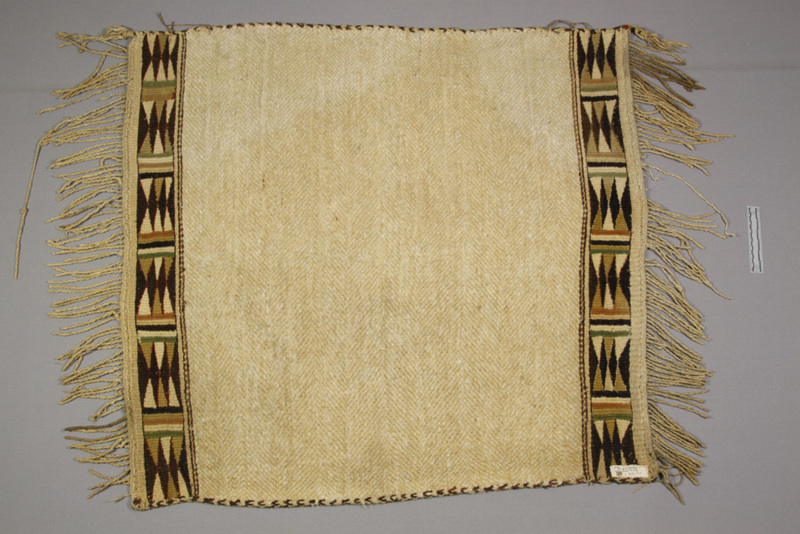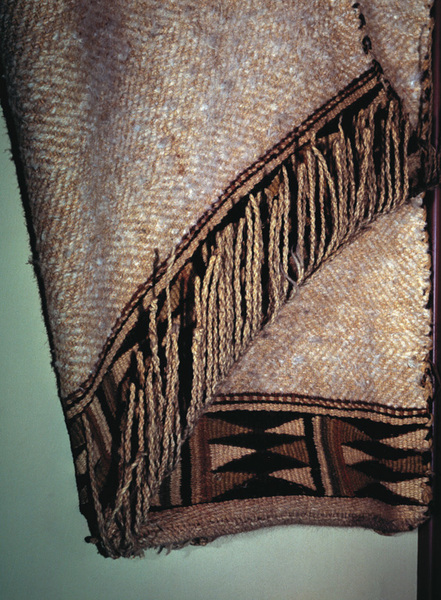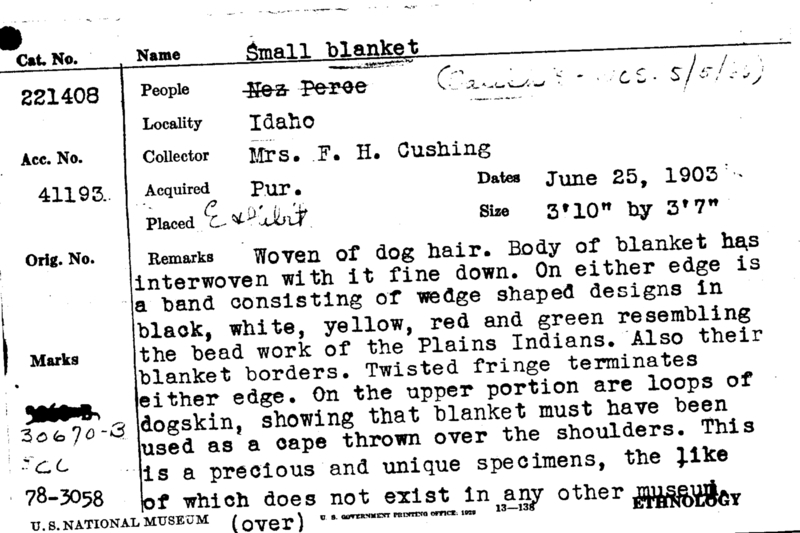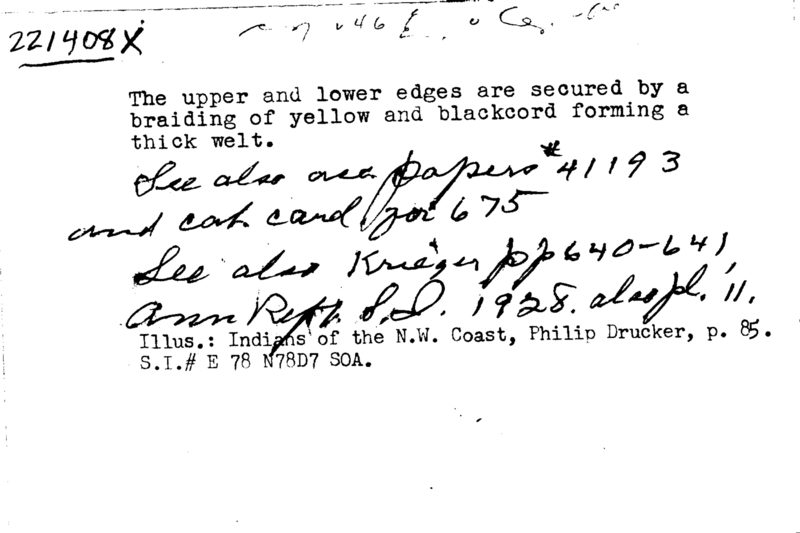Small Blanket Item Number: E221408-0 from the National Museum of Natural History







Notes
ORIGINALLY CATALOGUED AS NEZ PERCE BUT REIDENTIFIED AS [COAST] SALISH? BY WILLIAM STURTEVANT 5-5-1966, PER NOTATION ON CATALOGUE CARD. FROM CARD: "WOVEN OF DOG HAIR. BODY OF BLANKET HAS INTERWOVEN WITH IT FINE DOWN. ON EITHER EDGE IS A BAND CONSISTING OF WEDGE SHAPED DESIGNS IN BLACK, WHITE, YELLOW, RED AND GREEN RESEMBLING THE BEADWORK OF THE PLAINS INDIANS. ALSO THEIR BLANKET BORDERS. TWISTED FRINGE TERMINATES EITHER EDGE. ON THE UPPER PORTION ARE LOOPS OF DOGSKIN, SHOWING THAT BLANKET MUST HAVE BEEN USED AS A CAPE THROWN OVER THE SHOULDERS. THIS IS A PRECIOUS AND UNIQUE SPECIMEN, THE LIKE OF WHICH DOES NOT EXIST IN ANY OTHER MUSEUM. THE UPPER AND LOWER EDGES ARE SECURED BY A BRAIDING OF YELLOW AND BLACK CORD FORMING A THICK WELT. SEE ALSO ACCESSION PAPERS #41193. SEE ALSO [H.W.]KRIEGER PP. 640-641, ANN. REPT. S.I. 1928, ALSO PL. 11. ILLUS.: INDIANS OF THE N.W. COAST, PHILIP DRUCKER, P. 85." NOTE THAT AT ONE TIME IT WAS THOUGHT CAT. # E675 HAD BEEN RECATALOGUED AS # E221408 (WHICH WAS NOTED ON THE CATALOGUE CARD FOR E675 AND PUBLISHED BY H.W. KRIEGER, SEE THE REFERENCE CITED ABOVE), HOWEVER THEY ARE ACTUALLY TWO DIFFERENT OBJECTS. KRIEGER, IN THE REFERENCE CITED ABOVE, SPECULATED THAT E221408 COULD HAVE BEEN COLLECTED BY GEORGE GIBBS IN THE 1850'S OR BY THE U.S. EXPLORING EXPEDITION OF 1838-1842. THE BASIS FOR THIS SPECULATION IS UNKNOWN. JANE WALSH HAS NOT LINKED THIS OBJECT TO THE U.S. EXPLORING EXPEDITION. - F. PICKERING 9-10-2012Illus. Fig. 49, p. 61 of Salish Weaving by Paula Gustafson, Univ. of Washington Press, 1980. Described on p. 125, cat. entry 85, of Gustafson as: "Fibres: Mountain goat hair and vegetable fibre mixed with unidentified fibres. Colour: Natural white; borders coloured black, white, brown, yellow and green. Weave: Twill; twined borders." Also described on p. 59 of Gustafson: "A twill woven blanket ... on first glance appears to fit the category of Hybrid Salish blankets, but the weft yarn is not the typical two-ply spun from mountain goat hair; it seems to be composed of some sort of fluff such as thistledown spun together with a stronger fibre. T.T. Waterman described this blanket as having "white down incorporated during the weaving" or spinning process, and the fluff may well be soft bird down."Sampling/analysis was done on hair from this blanket in 2004, with the results concluding that this blanket includes both mountain goat hair and Salish wool or woolly dog hair (see Anthropology Conservation Lab sampling file "Loychuk 2004.").Reference: Solazzo, C., S. Heald, M.W. Ballard, D.A. Ashford, P.T. DePriest, R.J. Koestler, and M. Collins. 2011. Proteomics and Coast Salish blankets: A tale of shaggy dogs? Antiquity 85: 1418-1432. http://antiquity.ac.uk/ant/085/ant0851418.htm . Identified there as a Hybrid (1850 and beyond) blanket - woven of down with animal fibers; weft/fringe Mountain goat hair; warp Mountain goat hair and Salish wool or woolly dog hair.Per Dr. Carla J. Dove, Smithsonian Feather Identification Lab, 2017: The physical avian identification below is based on examination of microscopic structures in the downy feathers and comparison of any whole feathers with museum study skins. Bird distributions and population status were considered in making the final species determination. Downy feathers were examined microscopically and found to be most similar to swan. Given the possible geographic origin of the object (Salish), and distribution and population status of avian species in the region, the most likely species is Trumpeter Swan (Cygnus buccinator).X-ray Fluorescence (XRF) testing was conducted on this textile in 2017. Arsenic was detected. The testing suggests this textile was treated with pesticides that contained arsenic. The testing indicates there are high levels of arsenic (1,000-10,000 ppm). See Anthropology Conservation Lab records for the full report. This object should be handled with gloves. See the Department of Anthropology "Statement on Potential Hazards (Inherent and Acquired) Associated with Collection Objects" for more detailed handling guidelines.Illus. Fig. 32, p. 90, in Tepper, Leslie Heymann, Janice George, and Willard Joseph. 2017. Salish Blankets: robes of protection and transformation, symbols of wealth.
Item History
- Made in USA
- Collected by Frank H. Cushing in USA
- Received from Mrs. Emily M. Cushing on June 25, 1903
What
- Name
- Small Blanket
- Identification Number
- E221408-0
- Type of Item
- blanket
Who
- Culture
- Salish
- Field Collector
- Frank H. Cushing
- Received from
- Mrs. Emily M. Cushing
Where
- Holding Institution
- National Museum of Natural History
- Made in
- USA
- Collected in
- USA
When
- Acquisition Date
- on June 25, 1903
Other
- Accession Number
- 041193